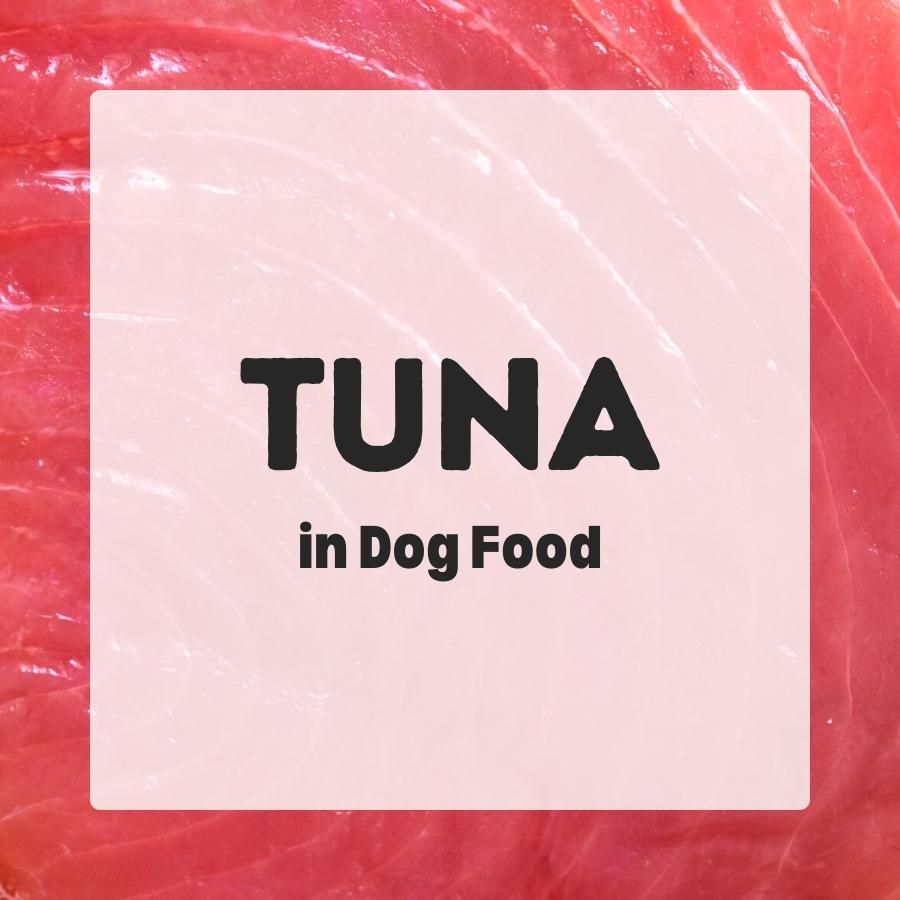Tuna is a common fish ingredient in dog foods, it is most commonly found in novel protein or premium diets.
Contents
Fresh Tuna
Tuna are agile predatory fish found in all the world’s oceans. They are also one of the most commercially valuable fish.
Tuna flesh is high in myoglobin which turns some tuna meats red.
About half of the world’s production of tuna is from the Pacific Ocean. Overall, there are several different species of tuna available in the US that can also be used by the pet food industry[7].
Skipjack tuna (Katsuwonus pelamis), for example, is one of the most widely used commercial fish but is not at risk of overfishing compared to other types of tuna. Other commonly available tuna species include yellowfin tuna, bigeye tuna, and albacore.
With about 14.500 tons used each year, tuna is one of the most widely used named fishery ingredients in dog foods[4].
Fresh tuna is used as a novel protein in some lines of dog food[6].
When it comes to using fresh tuna as a dog food ingredient, dog owners can expect a range of essential nutrients.
Tuna is a rich source of protein, vitamins, and minerals, including vitamin D, B12, and selenium. It also contains omega-3 fatty acids, which support healthy skin and coat and overall well-being.
Tuna is also a great source of taurine[5].
| Nutrients in 100 g[8] | Skipjack |
|---|---|
| Water | 70.6 g |
| Energy | 103 kcal |
| Protein | 22 g |
| Fat | 1.01 g |
| Ash | 1.3 g |
| Amino acids | |
| Arginine | 1.32 g |
| Histidine | 0.648 g |
| Isoleucine | 1.01 g |
| Leucine | 1.79 g |
| Lysine | 2.02 g |
| Methionine | 0.651 g |
| Threonine | 0.964 g |
| Phenylalanine | 0.859 g |
| Tryptophan | 0.246 g |
| Valine | 1.13 g |
| Fatty acids | |
| Saturated | 0.328 g |
| Monounsaturated | 0.19 g |
| Polyunsaturated | 0.315 g |
| – Docosahexaenoic acid (DHA) | 0.185 g |
| – Eicosapentaenoic acid (EPA) | 0.071 g |
| – Docosapentaenoic acid (DPA) | 0.013 g |
| – Arachidonic acid (ARA) | 0.026 g |
| – Linoleic acid | 0.016 g |
| Cholesterol | 47 mg |
| Minerals | |
| Calcium | 29 mg |
| Iron | 1.25 mg |
| Magnesium | 34 mg |
| Phosphorus | 222 mg |
| Potassium | 407 mg |
| Sodium | 37 mg |
| Zinc | 0.82 mg |
| Copper | 0.086 mg |
| Manganese | 0.015 mg |
| Selenium | 36.5 µg |
| Vitamins | |
| Vitamin C | 1 mg |
| Vitamin A | 16 µg |
| Thiamin | 0.033 mg |
| Riboflavin | 0.1 mg |
| Niacin | 15.4 mg |
| Pantothenic acid | 0.42 mg |
| Vitamin B6 | 0.85 mg |
| Vitamin B12 | 1.9 µg |
| Folate | 9 µg |
However, it’s important to note that some rarer types of tuna are considered overfished or critically endangered, which can have a negative impact on the environment.
And being a predatory fish, it can accumulate mercury and other pollutants. The mercury content in tuna species can vary widely.
Overall, tuna is a valuable ingredient in dog food products due to its high nutritional value and palatability. But it’s crucial to choose dog food products that use responsibly sourced tuna and to be mindful of the impact our choices have on the environment.
Tuna Meal
Per the AAFCO guidelines, it is made from dried and ground whole tuna or fish cuttings and can be semi-defatted[1].
It can be a way to upcycle tuna by-products from canneries.
These by-products may include heads, fins, skin, tails, bones, and viscera such as gills, heart, liver, spleen, stomach or intestines[1].
Tuna meal recycles discarded fish or leftovers from tuna canneries into a concentrated fish protein ingredient.
Tuna Oil
Tuna oil is separated during the rendering of whole fish or cannery waste into tuna meal[1].
As well as providing energy and flavor, tuna oil contains high amounts of beneficial omega-3 fatty acids.
Further Reading
[1] AAFCO Official Publication. Chapter 6. Free Access.
[2] U.S. Department of Agriculture. Agricultural Research Service. FoodData Central. 2019. fdc.nal.usda.gov
[3] Aldrich: Rendered Products in Pet Food. Published in Essential Rendering (pdf). 2006.
[4] Pet Food Production and Ingredient Analysis (PDF). 2020. Institute for Feed Education and Research (IFEEDER), North American Renderers Association (NARA), Pet Food Institute (PFI)
[5] WebMD (2022): Top Foods High in Taurine.
[6] Yathavamoorthi et al. Tuna Red Meat as a Novel Ingredient in Pet Food for Dogs. Journal of Aquatic Food Product Technology. 2020. https://doi.org/10.1080/10498850.2020.1799468
[7] 21 CFR §161.190 Canned tuna.
[8] U.S. Department of Agriculture. Agricultural Research Service. FoodData Central. 2019. fdc.nal.usda.gov
